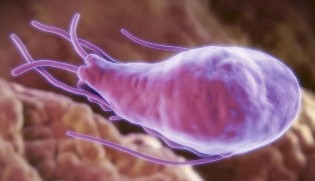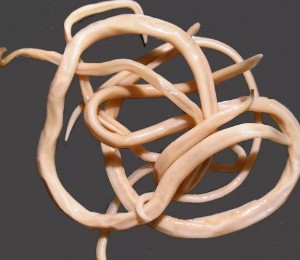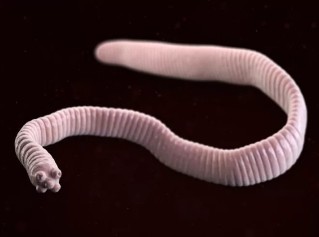Types of parasites in the human body exclusively various. In his number, along with a lot of-cell and protozoa are also part of the viruses, bacteria and fungi that parasites at the expense of the human body, although the doctor in the tradition of the bacteria and viruses are not considered one of the parasites.

In humans, different types of parasites are localized not only in the intestine, as is often thought, but also in many other organs: blood, the tissues of the muscles, joints, the brain (the brain and the spinal) and even in the eyes.
Are particularly vulnerable internal organs such as the gastrointestinal tract, the liver, the lungs, the heart.
The stay of the parasites in the human body is not innocent. Their negative consequences is, first of all, in the fact that absorb a large part of the food of useful substances, without which the full functioning of the body is impossible.
The imbalance is exacerbated by the intoxication of the organism of the person on account of toxins, which target the parasite, which can lead to the development of a series of diseases, to the malignant. Often, diseases caused by parasites, take a chronic character.
A special danger lies in the fact that the parasitic diseases cause symptoms that are characteristic of other, more often intestinal infections, therefore, it is very important to the appropriate differential diagnosis to the identification of the species of the parasite and the formulation of adequate treatment tactics.
Types of human parasites, in general, can be divided into two large groups:
- ectoparasite, living as a parasite on the surface of the body and feed on human blood (bed bugs, fleas, lice, ticks); they serve as vectors of pathogens such infections, such as encephalitis, typhoid fever, anthrax, and others;
- endoparasite, living as a parasite in the internal organs and cause serious diseases; among them, protozoa (giardia, amoeba, trichomonas, Toxoplasma) and helminths – parasitic worms (worms).
Classification of the parasites

We will consider the main types of endoparasites human. The appearance of many of them can be seen only under the microscope, and some, in particular, helminths, surprised by its dimensions. We will start with the most simple:
- Giardia along with dysbiosis are also the cause of the IMR, anemia and intoxication of the organism.
- Toxoplasma affects the brain, the eyes, the heart muscle, the nervous system, but the danger they pose to pregnant women because of the risk of fetal death or serious of their defeats.
- Amoebae are capable of causing amoebic dysentery, amoebic encephalitis and other dangerous diseases.
- Trichomonas are the origins of infectious diseases of the nervous system.
Most common parasites
The most common form of endoparasite are, without doubt, helminths (worms), which, according to various sources, infected more than 80% of the population of the planet.
A large number of these parasites are divided into to main types:
- nematodes – nematodes (ascaride, ostritsy, Trichinella, vlasoglav etc);
- cestodes – tape worms (lentetsy, pig and bull tsepen, Echinococcus etc);
- trematody – worms-flukes (liver, blood, lung, as well as the trematodes that inhabit the intestine).
You can sometimes find more of a common classification, according to which all types of parasites of people are divided into:
- bowel, infect in the intestine;
- cloth, localized in other organs and tissues.
However, the majority of helminths in the different stages of their life cycle spend and fabric, and the intestinal period of development with the sintomatologa.
Let's look at a brief description of the most common species of helminths.
Round worms (nematodes)
- Ascaride most common of the nematodes of the length of 20 to 40 cm, parasites in the small intestine, but previously to migrate in the human body, to the surprise of the circulatory and the respiratory system. Along with the bowel of these parasites can be found in the liver and the gall bladder, the heart and the lungs. Frequent symptom living with roundworm – an allergic reaction.
- Ostritsy small worms, up to 1 cm, which affect the bowel and cause enterobiasis with the disorder work gastrointestinal, fatigue, sleep disorders, and other Hallmark symptom of the presence of pinworms – itching in the area of the anus, where they lay their eggs.
- Trichinella – these worms are microscopic in size in only a few millimeters) lead to a large disease – trihinellez, which may, in the absence of treatment lead to death. The adults inhabit the body of the people in the muscle (respiratory, facial, and other), causing muscle aches, fever, swelling, allergic skin rashes.
- Vlasoglavy – small worms (length of up to 4.5 cm, with the front part of the body

The larvae are called trichocephalosis with acute diarrhea, abdominal pain and other symptoms that are reminiscent of the appendicitis. As A result of the intoxication of the organism develops anemia.
Tape worms (cestodes)
- The choice of lentets, the body length of a prison term of up to 10 m, leads to the development of the difillobotrioz with nausea, weakness, vomiting, unstable chair, asthenia, and anemia.
- Swine tsepen has a length of 3 to 8 m, parasitizes mainly in the small intestine and causes two diseases: taeniasis with dyspeptic, asthenic-neurotic and abdominalnim by syndromes, and the cysticercosis with intoxication, intestinal, allergic, and respiratory syndromes. Depending on the location of tsistitserki the involvement of the muscles, the brain, the heart, eyes and other
- Bullish tsepen, of a length that can reach up to 18 m, causes the beef tapeworm infection, and is considered one of the most dangerous species of worms. If you do not question what to do dehelmintization, you can live in the human body up to 18-20 years. It is located in the colon, causes a strong intoxication by the products of their livelihoods, as well as diarrhea, nausea, vomiting, abdominal pain, anemia, allergic reactions, and problems with the nervous system.
- Dwarfish tsepen of the total length of 1.5-5 cm from the source of the gimenolepidoz with dyspeptic, armbar and asthenic-neurotic syndromes that affect, above all, digestive, and nervous systems of the body, as well as the liver.
- Echinococcus is considered the most fine of the tape worm – its length is only 2.5 to 8, rarely 9 mm, however, the infection will have terrible consequences in the form of lesions in the liver and lungs, where they form cysts and tumors that cause the dysfunction of these organs.

Worms-flukes (trematody)
- Liver fluke, or fluke liver shape resembles a length of 30 to 50 mm and a width of 8 to 13 mm, it has a suction cup. Damages the sheath of the liver and sticking the bile ducts, is capable of coating completely the reflux of bile. Can lead to cirrhosis, jaundice and liver cancer.
- Cat (siberian) fluke, or fluke feline, plane of the worm length from 4 to 13 mm from the Location of the ducts of the gallbladder, the liver and the pancreas. Called opisthorchiasis with the development of gastritis, ulcers, pancreatitis, acute cholecystitis, until the cancer of the liver, which can lead to death.
- Lung fluke is ovoid in shape, red-brown body with small spines, length of 7.5 to 12 mm with a width of 4 to 8 mm Affects the lungs, causing inflammation, pleural effusion, exudative, focal fibrosis, and lung cancer. Penetrate into the brain causes encephalitis and meningoencephalitis.
- Schistosoma (blood flukes) – razdelnopolie worms the size of 1-2 cm, the eggs that cause the increase in the size of the liver, spleen, and lymph nodes, the formation of polyps in the intestine, diarrhea, granulomatous inflammation, leading to cancer of the bladder.
The sources of infection

Intestinal parasites can cause numerous health problems that reduce the life of 15-25 years. Many of the parasites is very difficult to detect. They can be anywhere - in the blood, the intestines, the lungs, the heart, the brain. The symptoms of the worm invasion, it can be confused with acute respiratory infections, gastro-intestinal diseases and other. The biggest mistake is that, in these cases, the delay! If you suspect the presence of parasites, it is necessary to consult a specialist. If to speak about the medications and self-treatment, is one of the most common helminths (Ascaris, pinworms, tapeworms), ideal for antiparasitic complex.
Intestinal parasites, like other diarrheal diseases, it is more often the "disease of dirty hands", which leads to the ingestion of eggs and larvae of helminths in the human body:
- when they do not wash their hands after using the bathroom and before eating;
- do not wash the vegetables, the fruits and vegetables that are consumed raw;
- do not put meat and fish sufficient heat treatment;
- when the consumption of bad fish salt and fat;
- leave prepared food available for the flies and cockroaches;
- use the stool as fertilizer in the garden garden sections;
- bathe in the not destined for it, the reservoirs;
- come in contact with stray animals.

However, and your pet may also get worms, because often animals serve as intermediate masters for the deworming, and the owner is a person.
The methods of struggle
- From the earliest age to instill in children the habit of washing hands. They should do it more often, as we constantly Potter in the sand, the dirt, the puddles, where the most favourable conditions for eggs and larvae of parasites, and contact with pets and stray animals.
- If you encounter any discomfort, can not exclude the helminthiasis, therefore, it is recommended to make an analysis corresponding to the parasite to determine the specific type of helminthes (against the majority of them there are medications.
- If the parasites are found in a member of the family, medications for helmintiasisa must take all.
- Popular medicine knows many ways, the way to get rid of the worms, and give him a good effect.
- Do not leave open dishes, bread, cakes, etc, so that flies or cockroaches as vectors of eggs of the worms – don't have left of their products.
- Carefully the temperature in the firing process: the meat and fish, often found the eggs of the helminths, either cook/roast/bake.
- It is good to wash under running water, the vegetables, the fruits, the vegetables that are consumed raw.
- Regularly deworming pets.
- Opt out of the use of the droppings as organic manure in his gardens, garden plots.
- When you travel to exotic countries of the extreme caution with the dishes of the local cuisine, especially the proposal in the street – there is no guarantee that they do not take something no less exotic vermes.






































